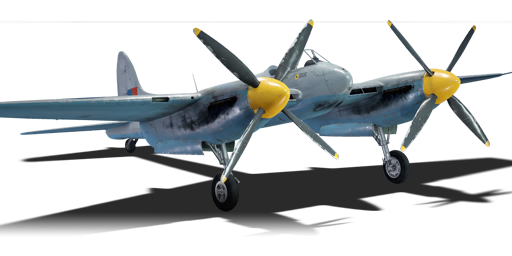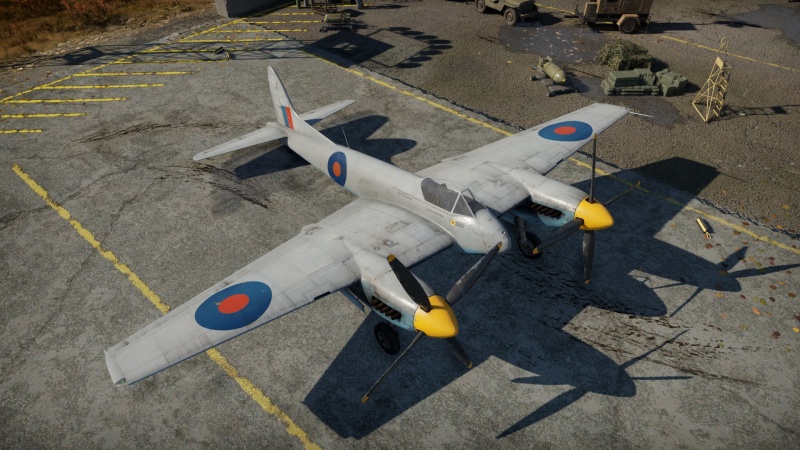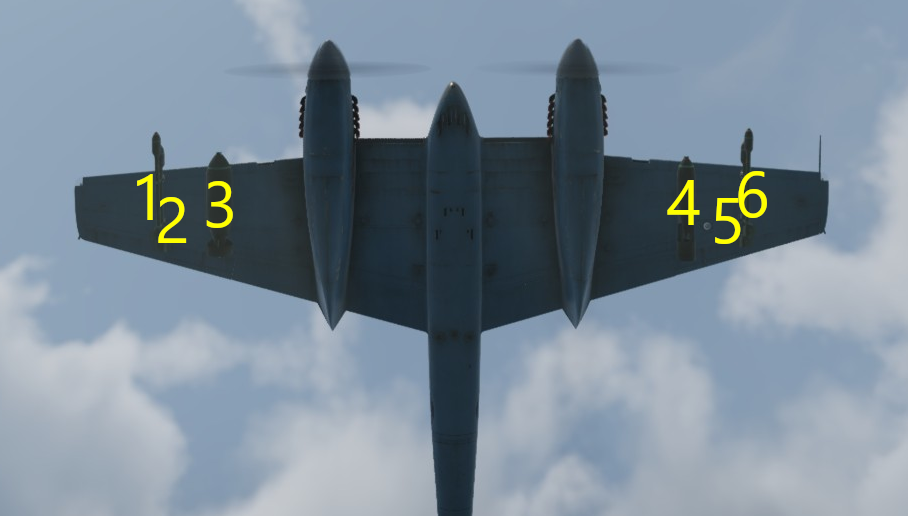Difference between revisions of "Hornet Mk.III"
(→Pros and cons) (Tag: Visual edit) |
(remove contradiction) |
||
| Line 22: | Line 22: | ||
For pilots who loved the Mosquito, the Hornet is a dream come true. | For pilots who loved the Mosquito, the Hornet is a dream come true. | ||
| − | As a descendant of the [[Mosquito FB Mk VI]], it maintains many similarities to its older brother, namely an all-wooden construction and the iconic de Havilland tail design. However, the Hornet somehow managed to improve on the already excellent Mosquito platform, increasing speed, manoeuvrability and armament while reducing overall aircraft proportions. From takeoff and into its flight, the Hornet is an overall smooth operator with brutal speed, insane climb rate, and excellent manoeuvrability, especially for a twin-engined fighter. However, it's still a twin-engined fighter which means it can still be outmanoeuvred by most single-engined opponents which it faces, namely Bf 109s and most Italian fighter aircraft. | + | As a descendant of the [[Mosquito FB Mk VI]], it maintains many similarities to its older brother, namely an all-wooden construction and the iconic de Havilland tail design. However, the Hornet somehow managed to improve on the already excellent Mosquito platform, increasing speed, manoeuvrability and armament while reducing overall aircraft proportions. From takeoff and into its flight, the Hornet is an overall smooth operator with brutal speed, insane climb rate, and excellent manoeuvrability with flaps, especially for a twin-engined fighter. However, it's still a twin-engined fighter which means it can still be outmanoeuvred by most single-engined opponents which it faces, namely Bf 109s and most Italian fighter aircraft. |
{| class="wikitable" style="text-align:center" width="70%" | {| class="wikitable" style="text-align:center" width="70%" | ||
Latest revision as of 14:12, 24 November 2024
| This page is about the British twin-engine fighter Hornet Mk.III. For the premium version, see Hornet Mk.I. |
Contents
Description
The DH.103 Hornet was a twin engine fighter developed by the de Havilland Company as a successor to the DH.98 Mosquito. The aircraft was introduced into the RAF at the end of World War II with the intention of being used in the Pacific Theatre against the Japanese Empire. It had notably long range, which was an excellent choice for covering large portions of land and sea in the colonies far from Europe. The aircraft was also used in strike missions during the Malayan Emergency, and it served from 1946-1956. The Hornet Mk.III was the most common variant of the Hornet with a total of 132 built.
Introduced in Update 1.71 "New E.R.A.", the Hornet sits at a BR where it can face both jets and very high-performance piston engine fighters. Common threats for the Hornet are the P-51H, the Bf 109 K, and early jets such as the F-80C and F-2H Banshee. The Hornet starts with an air defence fighter spawn. This allows the Hornet to climb to very high altitudes from the beginning of the match and have a good position from which start diving into enemies. The Hornet lacks an airbrake, but also has a hard time gaining speed past 750 km/h, this is very helpful to avoid being pursued by other props, since you can stay in a dive much longer than them. The Hornet also has very good high speed handling and it will pull high G turns at those speeds without any problem. But it is still a very large aircraft and not very manoeuvrable compared to a single engine fighter, so staying fast and high is its best bet.
General info
Flight performance
For pilots who loved the Mosquito, the Hornet is a dream come true.
As a descendant of the Mosquito FB Mk VI, it maintains many similarities to its older brother, namely an all-wooden construction and the iconic de Havilland tail design. However, the Hornet somehow managed to improve on the already excellent Mosquito platform, increasing speed, manoeuvrability and armament while reducing overall aircraft proportions. From takeoff and into its flight, the Hornet is an overall smooth operator with brutal speed, insane climb rate, and excellent manoeuvrability with flaps, especially for a twin-engined fighter. However, it's still a twin-engined fighter which means it can still be outmanoeuvred by most single-engined opponents which it faces, namely Bf 109s and most Italian fighter aircraft.
| Characteristics | Max Speed (km/h at 5,791 m) |
Max altitude (metres) |
Turn time (seconds) |
Rate of climb (metres/second) |
Take-off run (metres) | |||
|---|---|---|---|---|---|---|---|---|
| AB | RB | AB | RB | AB | RB | |||
| Stock | 716 | 698 | 11500 | 26.8 | 27.5 | 19.2 | 19.2 | 500 |
| Upgraded | 833 | 787 | 23.9 | 24.0 | 44.1 | 30.3 | ||
Details
| Features | ||||
|---|---|---|---|---|
| Combat flaps | Take-off flaps | Landing flaps | Air brakes | Arrestor gear |
| ✓ | ✓ | ✓ | X | X |
| Limits | ||||||
|---|---|---|---|---|---|---|
| Wings (km/h) | Gear (km/h) | Flaps (km/h) | Max Static G | |||
| Combat | Take-off | Landing | + | - | ||
| 826 | 324 | 370 | 356 | 287 | ~8 | ~4 |
| Optimal velocities (km/h) | |||
|---|---|---|---|
| Ailerons | Rudder | Elevators | Radiator |
| < 420 | < 390 | < 450 | > 324 |
Survivability and armour
- 38 mm Bulletproof glass in front of the pilot
- 12.7 mm Steel plate behind the pilot
- Two 3 mm Steel boxes behind the pilot in the fuselage
- Critical components located at the front of aircraft (fuel, pilot, engine, controls)
- Lots of fuel tanks in the wings
Modifications and economy
Your intended role of the Hornet decides which upgrades you go for first. When going for a ground attacker, focus on the payload modules and cannon upgrades, with survivability modules coming next due to needing to lower the extra weight the payloads add.
When going for any other role, the belts and cannons should come first, followed by the performance upgrades, ultimately leading to Engine Injection and 150 octane fuel, adding a whopping 245 and 288 horsepower respectively.
Armaments
Offensive armament
The Hornet Mk.III is armed with:
- 4 x 20 mm Hispano Mk.V cannons, chin-mounted (190 rpg = 760 total)
Suspended armament
The Hornet Mk.III can be outfitted with the following ordnance:
| 1 | 2 | 3 | 4 | 5 | 6 | ||
|---|---|---|---|---|---|---|---|
| 500 lb G.P. Mk.IV bombs | 1* | 1* | |||||
| 1,000 lb M.C. Mk.I bombs | 1* | 1* | |||||
| AP Mk I rockets | 2 | 2* | 2* | 2 | |||
| AP Mk II rockets | 2 | 2* | 2* | 2 | |||
| RP-3 rockets | 2 | 2* | 2* | 2 | |||
| * Bombs on hardpoints 3/4 cannot be equipped in conjunction with rockets on adjacent hardpoints | |||||||
| Default weapon presets | |
|---|---|
| |
Usage in battles
Being a descendant of the legendary Mosquito, one should expect a similar playstyle with the Hornet. However, due to the vastly improved performance, the aircraft can perform amicably in most situations it is thrown in.
Fighter: The Hornet does very well in a dogfighting situation for a heavy fighter. It can use its powerful quad Hispano Mk.Vs to shred any fighter which falls within its gun sights. The incredible top speed and acceleration/climb rate allow it to gain and maintain energy advantages over most of its competition. From there the Hornet can pick and choose when to attack. Since you cannot fall back on manoeuvrability to shake enemy fighters from your six, playing the Hornet requires good situational awareness and a general understanding of the enemies' top speed, climb rate, and energy, as you must prevent enemy fighters from catching you if you want to stay alive. Never assume you can outmanoeuvre an enemy plane, so always rely on speed and altitude to stay alive. While flying the Hornet can often require periods of extending/increasing your energy advantage before re-engaging, it is important to stay aggressive. Support your teammates whenever you can (clearing enemies from their six, dragging enemies away so they can focus on a single enemy, etc.) or you may soon find yourself alone versus multiple enemy fighters, a situation even the powerful Hornet can struggle in. The Hornet's ability to swoop in, make a high-speed guns pass, then extend away safely vs everything with a propeller can make it a valuable addition to any team. Even if it can't get guns on target, the enemy has to dodge the Hornet and this provides opportunities for more nimble allies to secure easy kills.
However, one should take note that most single-engined fighters (and even some medium bombers) will turn circles around the Hornet, so turn-fighting should be avoided whenever possible. Use the Hornet's high speed, climb rate, and energy retention to stay safe from enemy guns until opportunities to attack present themselves, because the Hornet will not be winning many turnfights. Pretty much any plane with forward-facing guns can cut inside the Hornet's turning radius at most speeds, so never enter 1-circle turnfights. The Hornet can however, win prolonged rate fights vs other poor turners with significantly less engine power (such as Do 335s), as the massive amount of power it generates allows it to maintain speed throughout turns even with the combat/takeoff flaps deployed. This is generally not the best way to fly the hornet, even when the rare opportunity to turnfight presents itself, as a low and slow Hornet is extremely vulnerable to anything that finds it.
High speed and great climb rate coupled with its amazing armament make the Hornet an extremely potent user of the Boom & Zoom fighting doctrine. Always attempt to maintain an energy and altitude advantage versus the enemy aircraft and avoid tunnel vision which means, be aware of the aircraft around you. Tunnel vision prevents you from seeing an enemy aircraft get the drop on you until its too late and either tracer fire is whizzing past or the Hornet's engine is on fire.
Ground Attacker: When upgraded, the Hornet can load 4 AP or RP-3 rockets and two 1,000 lb bombs. This, combined with the performance of the Hornet and power of the Hispanos allow it to be an amazing ground attacker that can shred any ground target in sight. The AP rockets are your best bet when it comes to ground attack, as they are more accurate than the RP-3s, fly faster, impact harder and penetrate more armour. However, when destroying light targets, the RP-3s are better due to the increased explosive filler.
Bomber Hunter: Due to its amazing performance, powerful armament and air defence fighter spawn point, the Hornet can make for a powerful interceptor when played carefully. Climb to bomber altitudes (4,000 metres and up) and begin prowling for a target. When attacking bombers, the worst angle of attack is from the rear, typically most bombers have their heaviest armament here, not to mention bullet impact is harder (especially from .50 calibre machine guns and 20 mm cannons) as the aircraft is flying towards a speeding bullet, increasing the damage it will do and the likelihood of being hit. Notable examples you can encounter at this rank are the B-29A-BN, B-17G-60-VE, PB4Y-2, He 177 A-5, G8N1 and the premium Be-6. Remember, the body of the aircraft can soak up a lot of damage, instead dive from above or climb from below and aim for the wings, without engines or a wing, the bomber will fall like a rock. Attacking from oblique angles makes it difficult for the bomber gunners to acquire a target solution and causes them to traverse and fire which spreads out their bullet patterns making it more difficult to hit a speeding target.
Manual Engine Control
| MEC elements | ||||||
|---|---|---|---|---|---|---|
| Mixer | Pitch | Radiator | Supercharger | Turbocharger | ||
| Oil | Water | Type | ||||
| Controllable | Controllable Auto control available |
Not controllable Not auto controlled |
Controllable Auto control available |
Combined | Controllable 2 gears |
Not controllable |
Pros and cons
Pros:
- Excellent armament, the Hispano Mk.V has a high rate of fire and causes a lot of fragmentation damage
- Extremely quick, can compete with some of the best single-engined fighters
- Has excellent payload options, several varieties of rockets and up to 2,000 lb in bombs
- Good amount of ammo for the cannons
- One of the fastest props at all altitudes
- Fantastic climb rate, especially when spaded, can beat the Do 335s to altitude
- Air defense fighter spawn means the Hornet will spawn higher than all planes except bombers.
- Thin body for a twin-engined fighter
- Experience with the Mosquito transitions between the planes
- Control surfaces remain effective even at redline speeds (which is good because speed is necessary to staying alive)
Cons:
- Not great at destroying heavy bombers like the He 177, susceptible to engine damage or a knocked out pilot
- Poor roll rate and turn rate
- Poor engine performance at high altitude
- Terrible nose authority due to rudder performance
- Despite the durable construction, the Hornet is made out of wood, meaning you cannot take much damage and remain in the fight
- Fires deal serious damage to the wooden airframe
- Wings are littered with fuel tanks
- Despite the thin body, it is still a large target
- Carrying the max payload has a significant effect on flight performance
History
The de Havilland Hornet first started out as a private venture by the de Havilland company. Having built the extremely successful Mosquito multi-role fighter, the company wants to improve on the design to make a faster and longer ranged heavy fighter. The project was soon developed to meet the Air Ministry specification F.12/43, which called for a fast, long-range fighter that operated in the Far East, in fact, the design was drawn around the Hornet. The first prototype was a more streamlined, smaller Mosquito with more powerful Rolls-Royce Merlin engines. The wings were designed for adaptation for naval uses and could fold. Pilot comfort and stability had a very high priority. According to accounts by test pilots, the Hornet is easily capable of taking on single engine fighters. It entered Squadron service in mid-1946. However, it was rarely used as World War Two was drawing to a close. Instead, the plane saw combat operations during the Malayan Emergency and continued to serve the RAF until 1956.
Media
- Skins
- Videos
See also
External links
- [Development] De Havilland Hornet: Deadly Sting!
- Official data sheet - more details about the performance
| De Havilland Aircraft Company Limited | |
|---|---|
| Fighters | Hornet Mk.I · Hornet Mk.III · Mosquito FB Mk VI · Mosquito FB Mk XVIII |
| Jet fighters | Vampire F.B.5 · Venom FB.4 · Sea Venom FAW 20 · Sea Vixen F.A.W. Mk.2 |
| Export | ␗Mosquito FB.Mk.26 · ▄Vampire FB 52A(Italy) · ▄Vampire FB 52A(Finland) · A28B |






